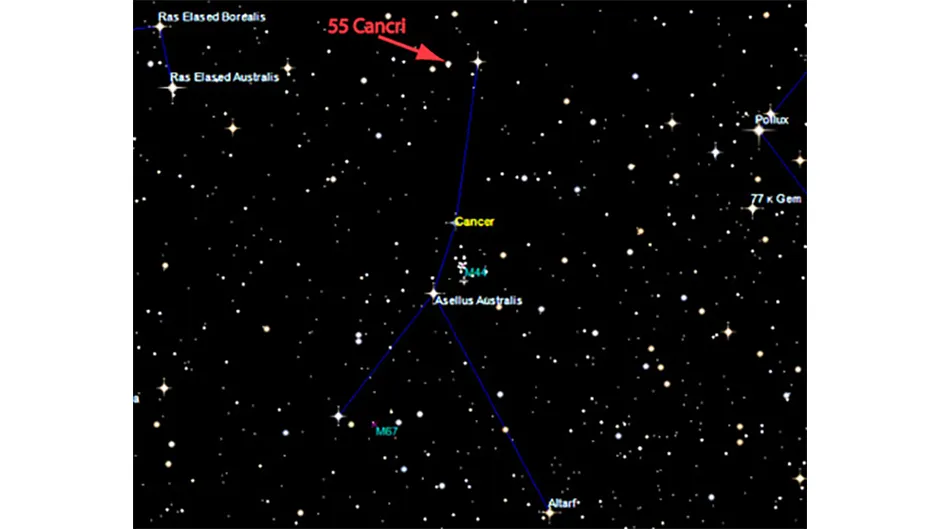Last week, researchers at Yale University announced that a relatively near ‘super-Earth’, 55 Cancri e, could be partly made of diamond.But the take home message isn't that we've found the Universe's biggest piece of space bling – it's that finding a world like our own may be much trickier than we'd thought.
Earth is carbon poor and oxygen rich, as is our entire Solar System.
The rocky worlds in our neighbourhood contain a high proportion of iron and silicate minerals, but – despite being one of the two core building blocks for life – carbon is much rarer.
55 Cancri e has a radius twice as large as Earth's and a mass eight times greater.
We call it a super-Earth because it’s more massive than our planet, but less than 10 solar masses.
It orbits 55 Cancri, a naked-eye star approximately 40 lightyears away in the constellation of Cancer.
This world was discovered in 2004 after astronomers noticed fluctuations in 55 Cancri’s radial velocity.
But it wasn't until 2011 that the planet was seen transiting its parent star, allowing astronomers to calculate its mass and radius with accuracy.
Using this data, as well as what we know about the chemical composition of 55 Cancri itself, the team at Yale infer that the planet may be up to one-third carbon.
Under the right temperature and pressure conditions, this carbon could even take the form of diamond.
“This is our first glimpse of a rocky world with a fundamentally different chemistry from Earth,” said lead researcher Nikku Madhusudhan in a statement.
“The surface of this planet is likely covered in graphite and diamond rather than water and granite.”
If they're right, it’s a stark contrast to the rocky worlds of our Solar System.
Current practice is to assume that a super-Earth has "Earth-centric compositions" when trying to explain observations, but the authors suggest that everything from atmosphere to biology could be different on a carbon-rich planet.
Suddenly the fact that surface temperatures on 55 Cancri e can reach up to 2,150°C doesn't seem like such a big hurdle to life as we know it.

Diamond dreams
The idea of a carbon planet is not new. In 2005, Dr Marc Kuchner of Princeton University suggested that such a planet could form if the protoplanetary disc surrounding a new star had extra carbon and too little oxygen – which is what Madhusudhan and colleagues believe may have happened in the case of 55 Cancri e.
55 Cancri e is not the first exoplanet thought to be carbon-rich. Wasp 12b, a gas giant 800 lightyears away in Auriga that’s being devoured by its parent star, clinched that title in 2008.
Three years later, scientists announced that PSR J1719-1438 b, which orbits a millisecond pulsar about 4,000 lightyears away in Serpens Cauda, is likely to be a white dwarf star that has had its matter stripped away to such an extent that it has become a mostly carbon ‘planet’.
It’s high density, they suggest, makes it likely that the carbon has crystallised into diamond.
But 55 Cancri e is believed to be first super-Earth to fit the bill.
Worlds of wonder
Diamond planets aren’t the only type of oddball world lurking out there.
Take GJ 1214b, another super-Earth orbiting another star 40 lightyears from us.
Discovered in 2009, it’s about 2.7 times wider than Earth and has a mass 6.5 times greater.
It also has a lot of something we’re desperately trying to find elsewhere in the Universe – water.
It isn’t water like we have on Earth though. GJ 1214b has a surface temperature of around 230°C and this, combined with the high pressures that occur on the planet, means the water is more likely to be a supercritical fluid.
When Kuchner mooted the concept of a carbon planet in 2005, he said:
"There's no reason to think that extrasolar planets will be just like the planets in the Solar System.
The possibilities are startling."
That much has been borne out by what astronomers have discovered since.
So the question is: which world hitherto confined to the imagination of science fiction authors and script writers are we going to find next?
